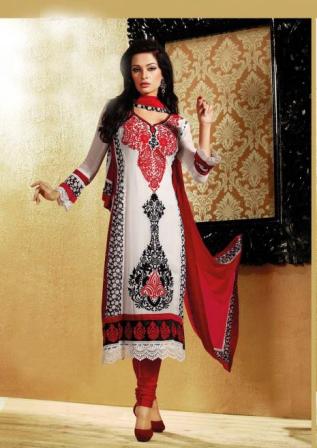ladies salwar suits Biogarphy
source(google.com.pk)Salwar kameez (also spelled shalwar kameez or shalwar qameez) is a traditional dress worn by both women and men in South Asia. Salvars or shalvars are loose pajama-like trousers. The legs are wide at the top, and narrow at the bottom. The kameez is a long shirt or tunic. The side seams (known as the chaak) are left open below the waist-line, which gives the wearer greater freedom of movement. In Afghanistan and Pakistan and India, the garment is worn by both sexes. In Bangladesh and Sri Lanka, it is most commonly a woman's garment, albeit still worn by some men.Salwars are gathered at the waist and held up by a drawstring or an elastic belt. The pants can be wide and baggy, or they can be quite narrow and made of fabric cut on the bias. In the latter case, they are known as churidars. The kameez is usually cut straight and flat; older kameez use traditional cuts, as shown in the illustration; modern kameez are more likely to have European-inspired set-in sleeves. The tailor's taste and skill are usually displayed not in the overall cut, but in the shape of the neckline and the decoration of the kameez.When women wear the salwar kameez, they usually wear a long scarf or shawl called a dupatta around the head or neck. For Muslim women, the dupatta is a less stringent alternative to the chador or burqa (see hijab and purdah). For Sikh and Hindu women (especially those from northern India, where the salwar kameez is most popular), the dupatta is useful when the head must be covered, as in a Gurdwara or a Temple, or the presence of elders. For other women, the dupatta is simply a stylish accessory that can be worn over one shoulder or draped around the chest and over both shoulders.Modern versions of the feminine salwar kameez can be much less modest than traditional versions. The kameez may be cut with a plunging neckline, sewn in diaphanous fabrics, or styled in sleeveless or cap-sleeve designs. The kameez side seams may be split high up to the waistline and, it may be worn with the salwar slung low on the hips. When women wear semi-transparent kameez (mostly as a party dress), they wear a choli or a cropped camisole underneath it.
The Shalwar kameez is sometimes known as "Punjabi suit," in Britain[1] and Canada.[2] In Britain, especially during the last two decades, the garment has been transformed from an everyday garment worn by immigrant South Asian women from the Punjab region to one with mainstream, and even high-fashion, appeal.In India, the garment was originally confined to the North, but as a convenient and modest alternative to a sari - and also as one that flatters practically any body-type - it has become popular across the nation. By varying the fabric, color and the level of embroidery and decoration, the salwar-kameez can be formal, casual, dressy, or plain; and it can also be made to suit practically all climates.Shalwar kameez have been in use for at least 2,000 years. The women from the royal graves found at the site of Tillya Tepe in northwestern Afghanistan, dating from c. early 1st century CE, were wearing shalwar kameez.[3]The pants, or salvar, are known as salvar in Panjabi; Punjabi: ਸਲਵਾਰ ਕ਼ਮੀਜ਼, salvaar or shalvaar શલવાર કમીઝ in Gujarati, salvaar or shalvar शलवार क़मीज़ in Hindi, and shalvar in Urdu: شلوار قمیض. The word comes from the Persian: شلوار, meaning pants, ultimately from Arabic sarwal : سروال, note the inversion of the letters ل and ر which has happened in the adaptation process.
The shirt, kameez or qamiz, takes its name from the Arabic qamis.that Arabic qamis is derived from the Latin camisia (shirt), which in its turn comes from the Proto-Indo-European kem (‘cloak’). [4]
that Mediaeval Latin camisia is a borrowing through Hellenistic Greek kamision from the Central Semitic root “qmṣ”, represented by Ugaritic qmṣ (‘garment’) and Arabic qamīṣ (‘shirt’). Both of these are related to the Hebrew verb qmṣ (‘grip’, ‘enclose with one’s hand’). [5]
Garments cut like the traditional kameez are known in many cultures; according to Dorothy Burnham, of the Royal Ontario Museum, the "seamless shirt," woven in one piece on warp-weighted looms, was superseded in early Roman times by cloth woven on vertical looms and carefully pieced so as not to waste any cloth. 10th century cotton shirts recovered from the Egyptian desert are cut much like the traditional kameez or the contemporary Egyptian jellabah or galabia.[6]Wide legged pants with drawstring were worn in many areas ruled by Turko-Iranian horse riding steppe peoples of Central Asia. The Ottoman Empire was ruled by Turks; many Iranian dynasties, including the recent Qajar dynasty, were of Turkic origin. Their characteristic clothing became court dress and eventually popular dress. Their wide-legged pants have been called Turko-Mongol[7] and Turco-Persian.[8] This style is still worn in contemporary Turkey and Iran.Starting in the 12th century, a series of raids and invasions established Islamic Turko-Iranian rule -- the Delhi sultanate and later the Moghul empire -- over much of what is now Pakistan and a small portion of north western India. The new rulers wore the kameez and the characteristic Turkish pants, which were called salwars or shalwars. Again, fashion followed rule and the salwar suit became popular throughout the area.
ladies salwar suits Photos Pictures Pics Images

ladies salwar suits Photos Pictures Pics Images

ladies salwar suits Photos Pictures Pics Images

ladies salwar suits Photos Pictures Pics Images

ladies salwar suits Photos Pictures Pics Images

ladies salwar suits Photos Pictures Pics Images

ladies salwar suits Photos Pictures Pics Images

ladies salwar suits Photos Pictures Pics Images

ladies salwar suits Photos Pictures Pics Images
No comments:
Post a Comment